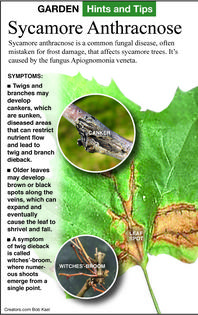The Greener View: Sycamore and Pin Oak Tree Problems
Sycamore and Pin Oak Tree Problems
Q: We have a sycamore tree that is having a problem leafing out this spring. What can we do to help keep it healthy?
A: Sycamores are found nationwide, and in some areas there has been a prolonged cool, wet spring. Once it finally warms up, they will be able to grow some healthy leaves.
Sycamores sometimes get a serious fungal disease called anthracnose. It attacks and kills the leaves and small twigs. All of the new leaves are killed until the weather warms up and dries out so that the fungus cannot spread. The fungus remains dormant in the litter that falls off the tree.
Over the summer, new branches will grow. They may die next spring. All of the short dead branches create the visual effect of a tree made from a bunch of broom handles.
During the summer, remove any dead leaves and twigs from the ground around the tree. If there are only a few dead or swollen twigs on the tree, remove them also. Since there are only a few months for the tree to produce enough food to survive the winter and produce new growth next spring, it should be fertilized now (in early summer) and again when the top goes dormant in the fall. Next spring when the new growth begins to sprout, the tree needs to be sprayed with a fungicide weekly until the weather warms up.
Sycamores are pretty trees, but they do not make good urban landscape trees for small landscapes. They have an unusual white bark that is produced by dropping the corky bark onto the lawn, adding more maintenance. The London plane tree is similar and very resistant to the anthracnose, but it does not have as pretty of a white bark.
Q: We have two pin oak trees, and one side of one tree turns yellow each summer. Why?
A: You are very lucky that both trees do not turn completely yellow. Pin oaks are very stately trees that grow straight and tall if they have good soil conditions. Unfortunately, that is rarely the case in urban areas in the Midwest and many other parts of the country.
These trees are very sensitive to low levels of available iron. When the soil is above a pH of 7.5, it's is difficult for the pin oak tree roots to extract the iron. There may be plenty of iron in the soil, and other plants will not show any yellowing, but the pin oak will have a problem. If it is not remedied, the tree weakens because the iron is necessary for chlorophyll production, which plants use to convert sunlight into plant food.
Pin oaks are also sensitive to excessively wet roots, so if there is a source of water keeping the roots wet, that can cause a problem. They do not like clay soil, and they prefer deep, acidic topsoil. If the landscape has undisturbed woodlot soil, then pin oaks will grow well, but new subdivision soil often does not work.
A quick short-term solution is to spray the leaves with a fertilizer preparation that contains iron. This gets the iron to the chlorophyll production site but does not solve the long-term problem of getting iron to the tree. This is a problem that starts in the soil but shows up in the leaves. The long-term solution is to correct the soil pH, which is very hard to do.
Pin oaks need to be planted in soil that is well-drained and acidic in nature. If necessary, drain lines need to be installed without cutting up and damaging the roots. Lowering the pH of the soil may take several years to accomplish. Applications of aluminum sulfate or ferrous sulfate around the tree and mixed into the soil will help. Fertilizing with an acidic fertilizer used for azaleas will also help.
There should be no lawn grass around the tree. Bark mulch should be extended several feet away from the trunk. None of the bark should be piled on the tree trunk. Other plants that love acidic soil can be planted in the mulched area. If possible, lots of peat moss should be worked into the soil where the tree roots will be growing.
(SET IMAGE) jru052825adAP.jpg (END IMAGE)
========
Email questions to Jeff Rugg at info@greenerview.com. To find out more about Jeff Rugg and read features by other Creators Syndicate writers and cartoonists, visit the Creators Syndicate website at www.creators.com.
Copyright 2025 Jeff Rugg. Distributed By Creators.








Comments